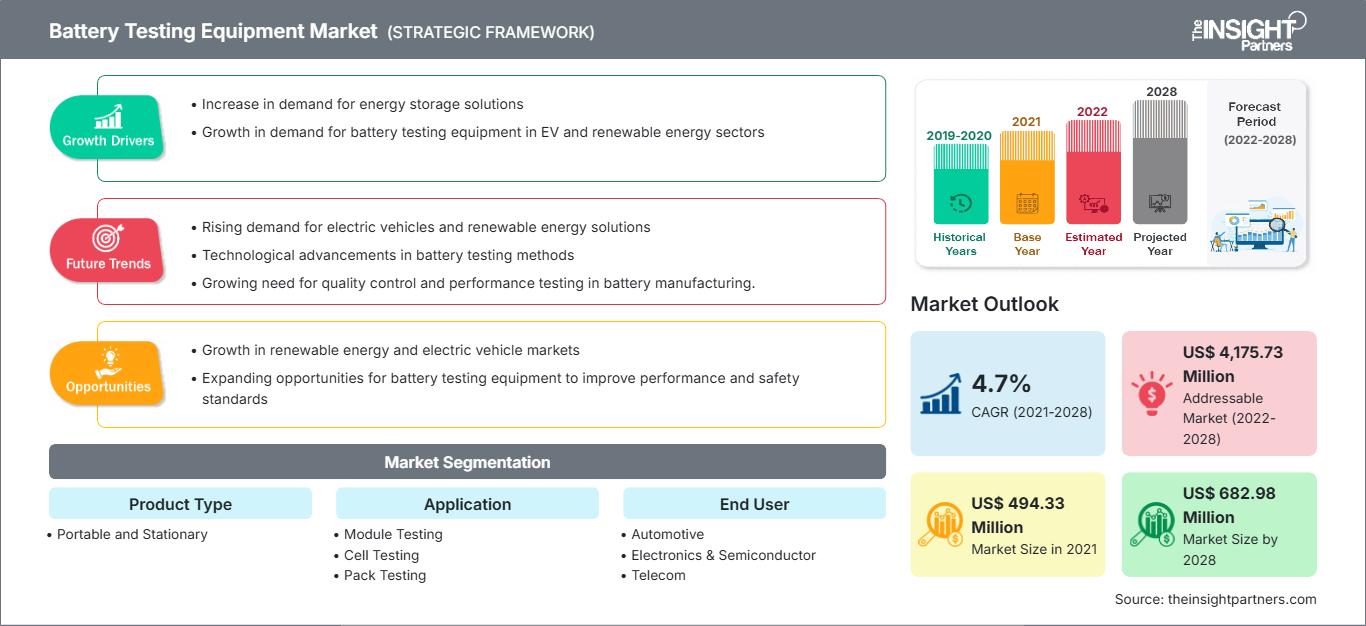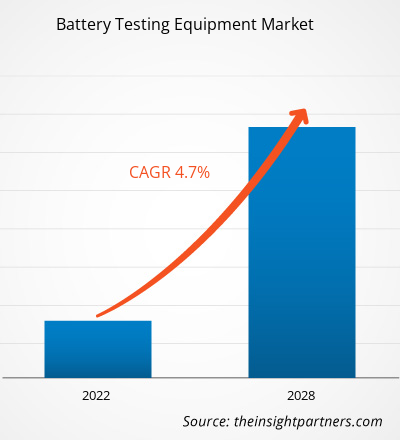배터리 테스트 장비 시장은 2021년 4억 9,433만 달러 규모였으며, 2028년에는 6억 8,298만 달러에 이를 것으로 예상됩니다. 2021년부터 2028년까지 연평균 성장률(CAGR) 4.7%로 성장할 것으로 예상됩니다.
항공우주 및 방위, 자동차, 의료 등의 산업은 첨단 장비로 역량을 강화하고 고객에게 향상된 서비스를 제공하기 위해 첨단 기술에 막대한 투자를 하고 있습니다. 미국, 프랑스, 스웨덴, 영국 등 여러 국가의 기업들이 전 세계 고객을 위해 첨단 배터리 테스트 장비를 개발하고 있습니다. 미 육군의 첨단 배터리 조달 증가 또한 시장 성장을 뒷받침하고 있습니다. 또한, eVTOL 개발과 독일, UAE, 싱가포르 등 각국 정부의 도시 항공 모빌리티 인프라 구축 계획은 배터리 테스트 장비 시장 참여자들의 성장을 촉진할 것으로 예상됩니다. 미국, 중국, 인도 등 여러 국가의 국방비 지출 증가는 향후 배터리 테스트 장비 시장 성장을 견인할 것으로 예상됩니다. 인도, 중국, 인도네시아 등 개발도상국들은 인접국과의 국경 분쟁 증가로 군사력 강화에 집중하고 있습니다. 중국과 인도 등지의 제조업 성장은 배터리 테스트 장비 시장 성장을 더욱 촉진하고 있습니다.
이 보고서의 일부, 국가 수준 분석, Excel 데이터 팩을 포함하여 모든 보고서에 대한 사용자 정의를 무료로 받을 수 있을 뿐만 아니라 스타트업 및 대학을 위한 훌륭한 제안 및 할인을 이용할 수 있습니다
배터리 테스트 장비 시장: 전략적 통찰력

- 이 보고서의 주요 주요 시장 동향을 확인하세요.이 무료 샘플에는 시장 동향부터 추정 및 예측에 이르기까지 데이터 분석이 포함됩니다.
COVID-19 팬데믹이 북미 배터리 테스트 장비 시장 성장에 미치는 영향
미국은 COVID-19로 인해 북미에서 가장 큰 피해를 입은 국가입니다. 많은 제조 시설이 일시적으로 폐쇄되거나 최소한의 직원으로 운영되고 있으며, 구성 요소 및 부품 공급망이 차질을 빚고 있습니다. 이는 북미 제조업체가 직면한 몇 가지 중요한 문제입니다.
미국에는 배터리 테스트 장비, 구성 요소 제조업체 및 산업이 많기 때문에 이번 사태는 각 생산 및 수익 창출에 심각한 영향을 미쳤습니다. 제조 직원 수 감소로 인해 생산량이 감소했습니다. 반면 원자재 공급 부족과 항공우주 산업 폐쇄는 미국 배터리 테스트 장비 시장에도 영향을 미쳤습니다. 그러나 미국의 군사 지출 증가와 테슬라와 같은 기업의 전기 자동차 개발 증가는 가까운 미래에 배터리 테스트 장비 시장 참여자에게 성장 기회를 제공할 것으로 예상됩니다.
시장 통찰력 - 배터리 테스트 장비 시장
교통 수요 증가로 시장 성장 견인
중국, 인도, 한국 등 개발도상국의 가처분소득 증가로 자동차 수요가 증가했습니다. 인도 자동차 제조업 협회(SIAM)에 따르면 인도의 승용차 판매량은 2019년 9월부터 2020년 9월까지 26.45% 증가했습니다. 주요 자동차 제조업체의 투자 증가와 아시아 태평양 지역의 자동차 제조에 대한 정부의 호의적인 규제 등의 요인이 이 지역의 배터리 테스트 장비 시장 성장을 견인할 것으로 예상됩니다. 또한 베트남과 같은 국가 정부의 자동차 산업 확장 계획 또한 배터리 테스트 장비 시장 규모를 견인할 것으로 예상됩니다.
제품 유형 기반 인사이트
제품 유형을 기준으로 배터리 테스트 장비 시장은 휴대용 배터리 테스트 장비와 고정형 배터리 테스트 장비로 구분됩니다. 고정형 배터리 테스트 장비 부문은 2020년 시장 점유율 54.1%로 배터리 테스트 장비 시장을 선도했습니다. 고정형 배터리 테스트는 배터리 신품 시 승인 시험의 일환으로 용량 시험을 수행하고, 배터리 기준값을 설정하기 위한 임피던스 시험을 수행하며, 배터리 보증을 위해 2년 이내에 상기 시험 과정을 반복합니다. 이 시험 과정은 밸브 조절형 납축전지(VRLA) 셀의 임피던스를 분기별로 점검하고, 예상 수명의 25%마다 용량 시험을 수행합니다.
애플리케이션 기반 인사이트
애플리케이션을 기준으로 배터리 테스트 장비 시장은 모듈 테스트, 셀 테스트, 팩 테스트로 세분화됩니다. 셀 테스트 부문은 2020년 시장을 선도했습니다. 셀 스트레스 테스트는 전기적, 환경적, 기계적 스트레스 등에 대한 반응을 평가하기 위해 수행됩니다. 셀 테스트는 긴 배터리 수명을 제공하고 복잡한 실제 테스트 프로파일을 시뮬레이션합니다. 또한, 셀 테스터는 리튬 이온 배터리, 전기 이중층 커패시터(EDLC), 리튬 이온 커패시터(LIC)에 대한 테스트를 수행하도록 설계되었습니다. 이는 배터리 테스트 장비 시장 규모를 확대할 것으로 예상됩니다.
배터리 테스트 장비 시장은 지역별로 북미, 유럽, 아시아 태평양, 중동 및 아프리카, 북미(SAM)의 5개 주요 지역으로 구분됩니다. 2020년에는 북미가 가장 큰 매출 점유율을 기록했으며, 유럽과 아시아 태평양 지역이 그 뒤를 이었습니다. 아시아 태평양 지역은 2020년부터 2028년까지 연평균 성장률(CAGR) 5.8%로 가장 빠르게 성장할 것으로 예상됩니다. Arbin Instruments, Century Yuasa Batteries Pty Ltd., Chauvin Arnoux, Chroma Systems Solutions, Inc., DV Power, Extech Instruments, Megger, Midtronics, Inc., Storage Battery Systems, LLC, Xiamen Tmax Battery Equipments Limited는 본 시장 조사에서 분석된 배터리 테스트 장비 생태계의 주요 기업입니다.
배터리 테스트 장비 시장 지역별 통찰력
The Insight Partners의 분석가들은 예측 기간 동안 배터리 테스트 장비 시장에 영향을 미치는 지역별 동향과 요인을 면밀히 분석했습니다. 이 섹션에서는 북미, 유럽, 아시아 태평양, 중동 및 아프리카, 중남미 지역의 배터리 테스트 장비 시장 부문 및 지역별 현황도 살펴봅니다.
배터리 테스트 장비 시장 보고서 범위
| 보고서 속성 | 세부 |
|---|---|
| 시장 규모 2021 | US$ 494.33 Million |
| 시장규모별 2028 | US$ 682.98 Million |
| 글로벌 CAGR (2021 - 2028) | 4.7% |
| 이전 데이터 | 2019-2020 |
| 예측 기간 | 2022-2028 |
| 다루는 세그먼트 |
By 제품 유형
|
| 포함된 지역 및 국가 | 북미
|
| 시장 선도 기업 및 주요 회사 프로필 |
|
배터리 테스트 장비 시장 참여자 밀도: 비즈니스 역학에 미치는 영향 이해
배터리 테스트 장비 시장은 소비자 선호도 변화, 기술 발전, 그리고 제품 이점에 대한 인식 제고 등의 요인으로 인한 최종 사용자 수요 증가에 힘입어 빠르게 성장하고 있습니다. 수요가 증가함에 따라 기업들은 제품 라인업을 확장하고, 소비자 니즈를 충족하기 위한 혁신을 추진하며, 새로운 트렌드를 적극 활용하고 있으며, 이는 시장 성장을 더욱 가속화하고 있습니다.

- 을 얻으세요 배터리 테스트 장비 시장 주요 주요 플레이어 개요
배터리 테스트 장비 시장에서 활동하는 업체들은 주로 첨단 고효율 제품 개발 및 협력에 집중하고 있습니다.
- 2021년, Keysight Technologies, Inc.와 Proventia Oy는 전기 자동차(EV) 배터리 테스트 솔루션 개선을 위해 협력했습니다.
- 2021년, Chroma는 CHAdeMO 협회의 전기 자동차 충전 인터페이스 스티뮬레이터 검사를 지원하는 전기 스쿠터 고속 충전 테스트 시스템을 출시했습니다. 또한, 전기 자동차 산업의 국제적 성장에 발맞춰 이륜 전기 자동차 고속 충전 테스트 표준을 위한 프로토콜 체크 시트(Protocol Check Sheet)를 정의하는 데에도 기여할 것입니다.
- 과거 분석(2년), 기준 연도, CAGR을 포함한 예측(7년)
- PEST 및 SWOT 분석
- 시장 규모 가치/거래량 - 글로벌, 지역, 국가
- 산업 및 경쟁 환경
- Excel 데이터세트
최근 보고서
관련 보고서
사용 후기
구매 이유
- 정보에 기반한 의사 결정
- 시장 역학 이해
- 경쟁 분석
- 고객 인사이트
- 시장 예측
- 위험 완화
- 전략 기획
- 투자 타당성 분석
- 신흥 시장 파악
- 마케팅 전략 강화
- 운영 효율성 향상
- 규제 동향에 발맞춰 대응




















 무료 샘플 받기 - 배터리 테스트 장비 시장
무료 샘플 받기 - 배터리 테스트 장비 시장